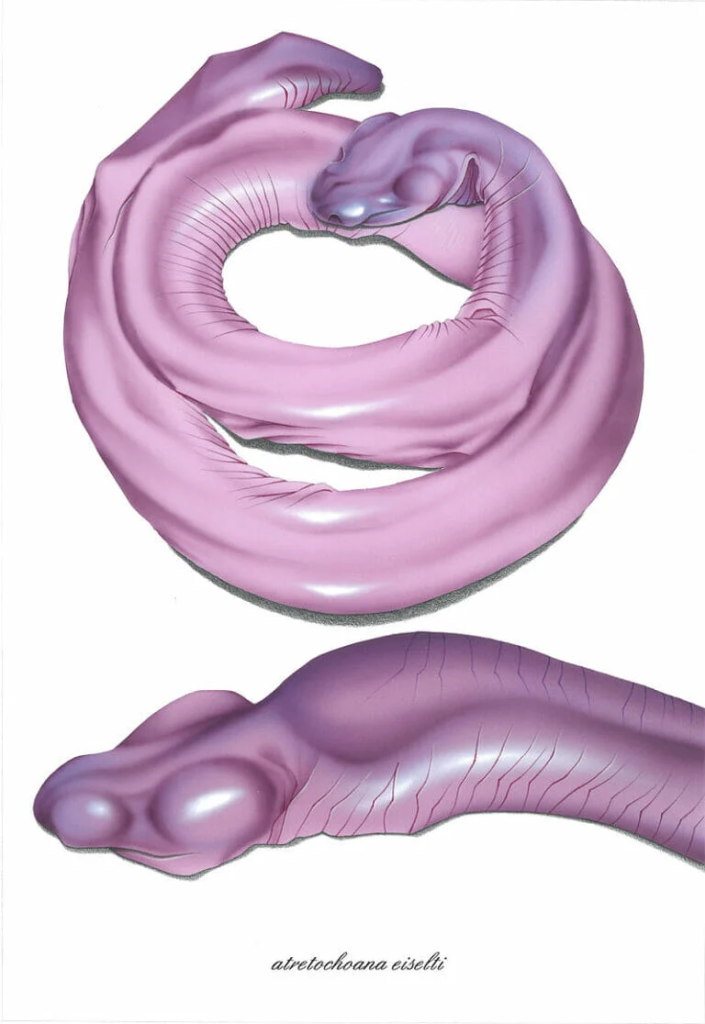
The animal world is full of surprises, with some creatures being more eye-catching than others because of their strange looks or unusual nature.
When I first saw a picture of this weird “penis snake,” I thought it was a joke. But, to my surprise, it turned out to be a real animal. So, let’s dive into the story behind the viral image that has left thousands of people in shock.
Throughout history, anything shaped like a phallus has grabbed attention and sparked curiosity. A few years ago, images of a strange-looking creature started making the rounds online, leaving many people scratching their heads in disbelief.
With its unique appearance, this mysterious animal quickly earned nicknames like the “penis snake,” “blind snake,” or the “man-aconda.”
But no, it’s not what you think.
Even though it looks a lot like a snake, this creature is actually called *Atretochoana eiselti*. It’s not a snake at all, but an amphibian, more closely related to a salamander. It’s also the largest known lungless tetrapod, which means it breathes through its skin instead of lungs.
This rare animal lives in the waters of the Amazon in Brazil and was hard to find for a long time. It was first discovered by Sir Graham Hales during an expedition with Sir Brian Doll in the late 1800s.
However, it wasn’t officially described until 1968. After more research, scientists reclassified it in 1996, giving it its own unique genus, *Atretochoana*.
In 2011, this species was rediscovered in the Amazon region. It lives only in the Amazon River and its largest tributary, the Madeira River in Brazil. The “penis snake” has only been found in this area and nowhere else in the world.
The viral pictures that blew up the internet a few years ago actually came from 2011. That’s when a whole family of these phallic-shaped creatures was found at the bottom of the Madeira River in Brazil. They were discovered when the river was drained during work on a hydroelectric dam.
Julian Tupan, a biologist working with the Santo Antonio Energy company on the dam, explained that not much is known about these lungless, limbless amphibians.
“Out of the six we collected, one died, three were released back into the wild, and two were kept for study,” he told *Estadao*, according to the U.K.’s *The Sun*.
Tupan pointed out that these “snakes” aren’t dangerous and are unlikely to show any aggressive behavior.
“Even though they look like snakes, they’re not reptiles; they’re more closely related to salamanders and frogs. We think the animal breathes through its skin and probably eats small fish and worms, but that hasn’t been proven yet.
“The Amazon is full of surprises when it comes to reptiles and amphibians. There’s still a lot more to discover.”
According to a paper published in the Brazilian scientific journal *Boletim do Museu Paraense Emílio Goeldi: Ciências Naturais*, one of these creatures found in the riverbed was photographed extensively. Some of the animals were released back into the Madeira River, while others were sent to the Emilio Goeldi Paraense Museum in Belem, Brazil.
The most popular photo, which Julian Tupan shared on Instagram, shows an adult female *A. eiselti* that’s just under 40 inches long.
Even though these creatures are fascinating, there’s still a lot we don’t know about them. One mystery that puzzles researchers is their diet. Scientists think these phallic-shaped animals might eat small fish, worms, and other aquatic invertebrates, but more research is needed to confirm this.

Another mystery about these creatures is how they breathe, as scientists haven’t confirmed the method yet. When the six specimens were discovered in 2011, it made things even more puzzling. What’s especially interesting is where they were found— in cold, fast-flowing water with limited oxygen. Since warmer water holds less oxygen, their ability to live without lungs is even more remarkable.
Based on these findings, scientists believe this species might be widespread across the Brazilian Amazon and could even extend into Bolivia.
Nature constantly surprises us with its endless wonders. From the deepest oceans to the tallest mountains, the natural world is full of amazing things waiting to be discovered.
Share this incredible story on Facebook with your friends and family to spark their curiosity and get them talking about the wonders of nature!
I Accidentally Discovered My Husband’s Cheating through an IG Post — My Public Yet Dignified Revenge Shook His World


During her seemingly joyous baby shower, Lora exposes her husband’s infidelity through a slideshow that shocks not only him and his mistress but also family and friends gathered under the guise of celebration. Follow along with this dramatic unmasking that not only shatters the facade of a happy family but also sets the stage for a decisive and meticulously planned fallout.
As I watched the soft morning light filter through the curtains, I cradled our six-week-old daughter, Lily, in my arms.
It was just another quiet morning, except it wasn’t. Tom was packing his suitcase again for the first time since Lily was born.
Before, his frequent travels were just a part of our routine—I’d kiss him goodbye and count the days until his return. But this time, everything felt different.
“Are you sure you have everything?” I asked, trying to keep my voice steady as Tom moved around our bedroom, gathering his belongings.
“Almost ready, Lora. I just need to grab a few more things,” Tom replied, his voice calm and reassuring. He glanced at Lily, sleeping peacefully against my chest. “I know this is hard. It’s just a week.”
A week. Seven days might not seem long, but to a new mom still figuring out how to juggle sleepless nights and endless diapers, it felt like an eternity.
“I just… I’ve never been alone with her, not really. What if I do something wrong?” My voice cracked slightly with the weight of my unspoken fears.
Tom stopped and sat next to us on the bed. He took my hand in his, squeezing gently. “Lora, you’re doing amazing. Honestly, you’re a natural at this. And hey, I’m just a phone call away, okay?”
I nodded, attempting a brave smile. “I know. It’s just—all those nights we talked about teamwork and now, suddenly, I have to do this solo.”
“We are still a team,” he reassured me, brushing a kiss on Lily’s forehead. “No matter where I am, we’re in this together.”
As he zipped up his suitcase, the reality of the impending solitude pressed down on me. I wasn’t just scared; I was terrified of being alone, not for my sake, but for Lily’s. What if she needed more than I could give?
Tom pulled us into a hug, his suitcase standing at the door like an unspoken barrier. “It’s going to be okay,” he whispered. “We’ll get through this. We always do.”
And with that, he was gone. I watched his car disappear around the corner and closed the front door gently behind me.
The rest of the day passed in a blur of feedings, diaper changes, and tender moments trying to soothe Lily’s fussing. By the time her cries finally gave way to sleep, the sun had set, leaving a calm evening to unfold.
I walked to the kitchen, poured myself a cup of hot chocolate, and sat on the balcony of our bedroom to unwind. It was my moment of respite, a brief pause in the constant demands of new motherhood.
I picked up my phone and opened Instagram, eager to immerse myself in something other than chores and diapers—a much-needed escape into the virtual world.
I scrolled through the vibrant pictures, catching glimpses of lives uninterrupted by the relentless needs of a newborn. Deep down, I felt a pang of longing—for the days when spontaneity was a given, not a luxury.
That’s when I stumbled upon our local celebrity, Anna Wren’s page, and without a second thought, I began browsing through her latest posts, unaware of the shock that was about to hit me.
She was celebrating at a new high-end restaurant downtown, her smile as radiant as the flash on the camera. The caption boasted about a night out with friends, a reminder of the world outside my baby-centric universe.
I zoomed in on the photo to admire the restaurant’s chic decor—a blend of modern and vintage that gave it a cozy yet elegant vibe. That’s when I saw them. In the softly blurred background, unmistakable even from a distance, was Tom.
He was sitting across from a woman, engaged in what looked like an animated conversation. I squinted, my heart pounding as recognition dawned.
It was Eliza, his university friend—the one who had never hidden her disdain for me. The one he had assured me was just a friend, someone I shouldn’t worry about.
The hot chocolate turned cold in my hands as I stared at the screen, my mind racing. Why hadn’t he told me about meeting her?
He was supposed to be on a business trip, confined to meetings and solo dinners, not cozy catch-ups with old friends who clearly didn’t think much of his wife.
Feeling a mix of anger and betrayal, I took a screenshot of the image. My next steps were unclear, but I knew I needed to confront him. This wasn’t just about his whereabouts; it was about trust, about the reality of our partnership now tested by distance and silence.
My mind was a tangled mess of emotions as I replayed the scene from Anna’s Instagram over and over. Tom, my husband, the father of our daughter, was on more than just a business trip. He was out there betraying our family.
But I wasn’t going to let my shock cloud my judgment. I needed to be strategic, meticulous.
First, I confirmed the hotel where Tom was staying by matching it with Anna’s tags about her influencer event. I had to be sure, absolutely sure.
So, I called my friend Mia, who had never met Tom. I asked her to do something that felt straight out of a spy movie—go to the hotel and take photos discreetly.
The pictures she sent back left no room for doubt: there was Tom and Eliza, unmistakably close, holding hands, kissing—a bitter confirmation of my worst fears.
The urge to confront him was overwhelming, yet I chose to wait. I planned every move with precision, as if setting up dominoes.
Quietly, I began funneling money into a separate account, knowing I might need every penny for what was coming. I met with a divorce attorney to understand my rights and the implications, especially concerning our newborn daughter, Lily.
His next business trip was my opportunity. I sent a bouquet of flowers to Tom’s hotel room with a note, carefully imitating Eliza’s handwriting, “Thank you for a wonderful evening, I can’t wait for many more.”
It was subtle but sharp, a dagger cloaked in velvet. The flowers were timed to arrive when Eliza was likely with him, planting seeds of doubt and paranoia.
When Tom returned, I kept my composure as if nothing had changed. Yet, under the calm surface, I was orchestrating the final act of my plan.
I suggested a belated baby shower, a seemingly innocent celebration with our close friends and family. I insisted we invite Eliza, claiming it would be nice to finally connect with his friends from Uni.
Tom, surprised by my suggestion, hesitantly agreed.
The day of the shower, our home filled with laughter and light chatter, a stark contrast to the storm brewing inside me. As guests cooed over Lily and exchanged pleasantries, I prepared the last piece of my revenge.
Midway through the event, I started a slideshow—cute photos of Lily, her milestones, and us as a new family. I even threw some in there with Tom’s extended family members.
Then, as the room hummed with warmth, the images shifted. There on the screen was the Instagram photo of Tom and Eliza in the background, unnoticed until now. The room fell silent. The next photos were Mia’s—clear shots of Tom and Eliza’s intimate moments.
The reaction was immediate and visceral. Whispers erupted around the room; Tom’s face drained of color, turning him ghostly pale. Eliza, caught in the glaring truth, stood up abruptly, her chair scraping loudly against the floor as she rushed out, humiliated.
The aftermath was chaotic. The room was still buzzing with the murmurs of our stunned friends and family as Tom turned to me, desperation etching his features. “Lora, please, let me explain. It’s not what it looks like,” he pleaded, his voice cracking under the strain.
I looked at him, my expression steady and resolute. “Save it, Tom. There’s nothing you could say to change what I saw. What we all saw.”
“But Lora—”
“No,” I cut him off firmly. The decision was made. “I’ve heard enough, Tom. Your actions spoke louder than your words ever could.”
I turned away from him, addressing the room briefly. “Thank you all for coming today. I think it’s best if we end the gathering now.”
As the guests slowly filed out, the whispers of disappointment and sympathy followed them out the door. Once everyone had left, I dialed my attorney, the evidence of Tom’s betrayal clear and undeniable. “I want to proceed with filing for divorce,” I informed her, my voice steady, backed by a painful certainty.
“Understood,” my attorney replied. “I’ll prepare the necessary paperwork. We have everything we need.”
Days later, the fallout continued. Tom’s parents, having learned of the incident, invited him over. I wasn’t there, but I heard about it from Tom later, his voice hollow. “We can’t believe you would do something like this,” his mother had said, disappointment heavy in her tone.
“We’re removing you from our will. You need to think about the consequences of your actions, especially how they affect your daughter.”
Tom recounted the meeting to me over the phone, a note of disbelief in his voice. “They’re serious, Lora. I’ve lost everything.”
“Yes, Tom,” I replied, my tone devoid of warmth. “You have.”
Whatever came next, I knew we would face it together, just me and my Lily, and that was enough.



Leave a Reply